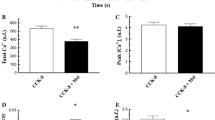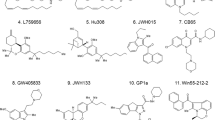Abstract
The enzyme responsible for the synthesis of nitric oxide (NO) from L-arginine in mammalian tissues is known as nitric oxide synthase (NOS) (EC.1.14.13.39). In the present study, the role of NO in the regulation of exocrine secretion was investigated in rat pancreatic acinar cells. Treatment of rat pancreatic acinar cells with cholecystokinin-octapeptide (CCK-OP) resulted in an increase in the arginine conversion to citrulline, the amount of NOx, the release of amylase, and the level of cGMP. Especially, CCK-OP-stimulated increase of arginine to citrulline transformation, the amount of NOx and cGMP level were completely counteracted by the inhibitor of NOS, NG-monomethyl-L-arginine (MMA), by contrast, that of amylase release was partially reduced. Furthermore, MMA-induced decrease of NOS activity and amylase release showed dose-dependent pattern. The data on the time course of CCK-OP-induced citrulline formation and cGMP rise indicate that NOS and guanylate cyclase were activated by treatment of CCK-OP. However, the mechanism of agonist-stimulated guanylate cyclase activation in acinar cells remains unknown. Therefore, activation of NOS is one of the early events in receptor-mediated cascade of reactions in pancreatic acinar cells and NO, not completely, but partially mediate pancreatic enzyme exocrine secretion.
Similar content being viewed by others
References Cited
Bernfeld, P., Amylases, α and β.Method in Enzymol., 1, 149–158 (1955).
Cox, R. D., Determination of nitrate and nitrite at the parts or billion level by chemiluminescence.Anal. Chem., 52, 332–335 (1980).
Gukovskaya, A. S. and Pandol, S. J., Nitric oxide production regulates cGMP formation and calcium influx in pancreatic acinar cells.Am. J. Physiol., 266, G350-G356 (1994).
Gukovskaya, A. S. and Pandol, S. J., Nitric oxide regulates neurotransmitter induced cGMP rise and Ca2+ influx in pancreatic acinar cells.Gastroenterology, 104, A306 (1993).
Yoshida, H., Tsunoda, Y. and Owyang, C., Effect of uncoupling NO/cGMP pathways on carbachol- and CCK-stimulated Ca2+ entry and amylase secretion from the rat pancreas.Pflugers Arch-Eur. J. Physiol., 434, 25–37 (1997).
Ignarro, L. J., Bugo, G. M., Byrns, R. E. and Chaudhuri, G., Endothelium-derived relaxing factor produced and released form artery and vein is nitric oxide.Proc. Natl. Acad. Sci. USA, 84, 9265–9269 (1987).
Moncada, S., Palmer, R. M. J. and Higgs, E. A., Nitric oxide: physiology and pharmacology.Pharmacol. Rev., 44, 109–14241 (1991).
Muallem, S., Calcium transport pathways of pancreatic acinar cells.Annu. Rev. Physiol., 51, 83–105 (1989).
Nathan, C. and Hibbs, J. B., Role of nitric oxide synthasis in macrophage antimicrobial activity.Curr. Opin. Immunol., 3, 65–70 (1991).
Nathan, C. and Xie, Q. W., Regulation of Biosynthesis of Nitric Oxide.J. Biol. Chem., 269(19), 13725–13728 (1994).
Pandol, S. J. and Schoeffield-Payne, M. S., Cyclic GMP mediates the agonist-stimulated increase in plasma membrane calcium entry in the pancreatic acinar cell.J. Biol. Chem., 265, 12846–12853 (1990).
Seo, D. W., Nam, S. W., Nam, T. K., Lee, Y. J., Ko, Y. K. and Lee, H. W., Effect of Cholecystokinin-pancreozymin on the Nitric Oxide Synthase Activity and cyclic GMP level in rat pancreatic tissue.Arch. Pharm. Res., 18, 434–439 (1995).
Solomon, T. E., Control of exocrine pancreatic secretion. In: Physiology of the Gastrointestinal tract, 2, 1173–1208 (1987).
Williams, J. A., Korc, M. and Dormer, R., Action of secretagogues on a new preparation of functionally intact, isolated pancreatic acini.Am. J. Physiol., 4(5), E517-E524 (1978).
Wrenn, R. W., Currie, M. G. and Herman, L. E., Nitric oxide participate in the regulation of pancreatic acinar cell secretion.Life Science, 55, N.7. 511–518 (1993).
Xu, X., Star, R. A., Tortorici, G. and Muallem, S., Depletion of intracellular Ca2+ stores activates nitricoxide synthase to generate cGMP and regulate Ca2+ influx.J. Biol. Chem., 269, 12645–12653 (1994).
Author information
Authors and Affiliations
Rights and permissions
About this article
Cite this article
Ahn, SH., Seo, DW., Ko, YK. et al. NO/cGMP pathway is involved in exocrine secretion from rat pancreatic acinar cells. Arch. Pharm. Res. 21, 657–663 (1998). https://doi.org/10.1007/BF02976753
Received:
Issue Date:
DOI: https://doi.org/10.1007/BF02976753




